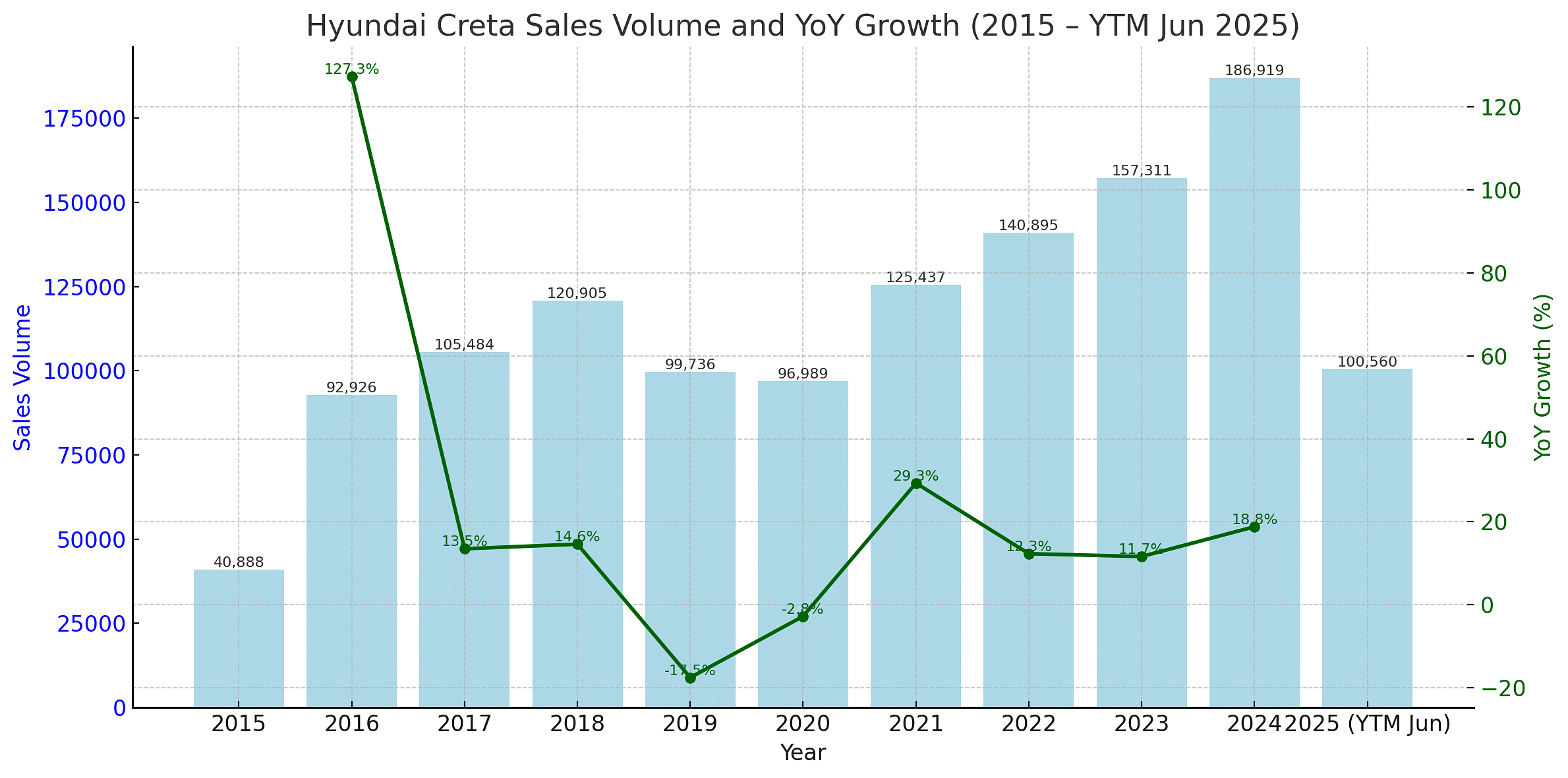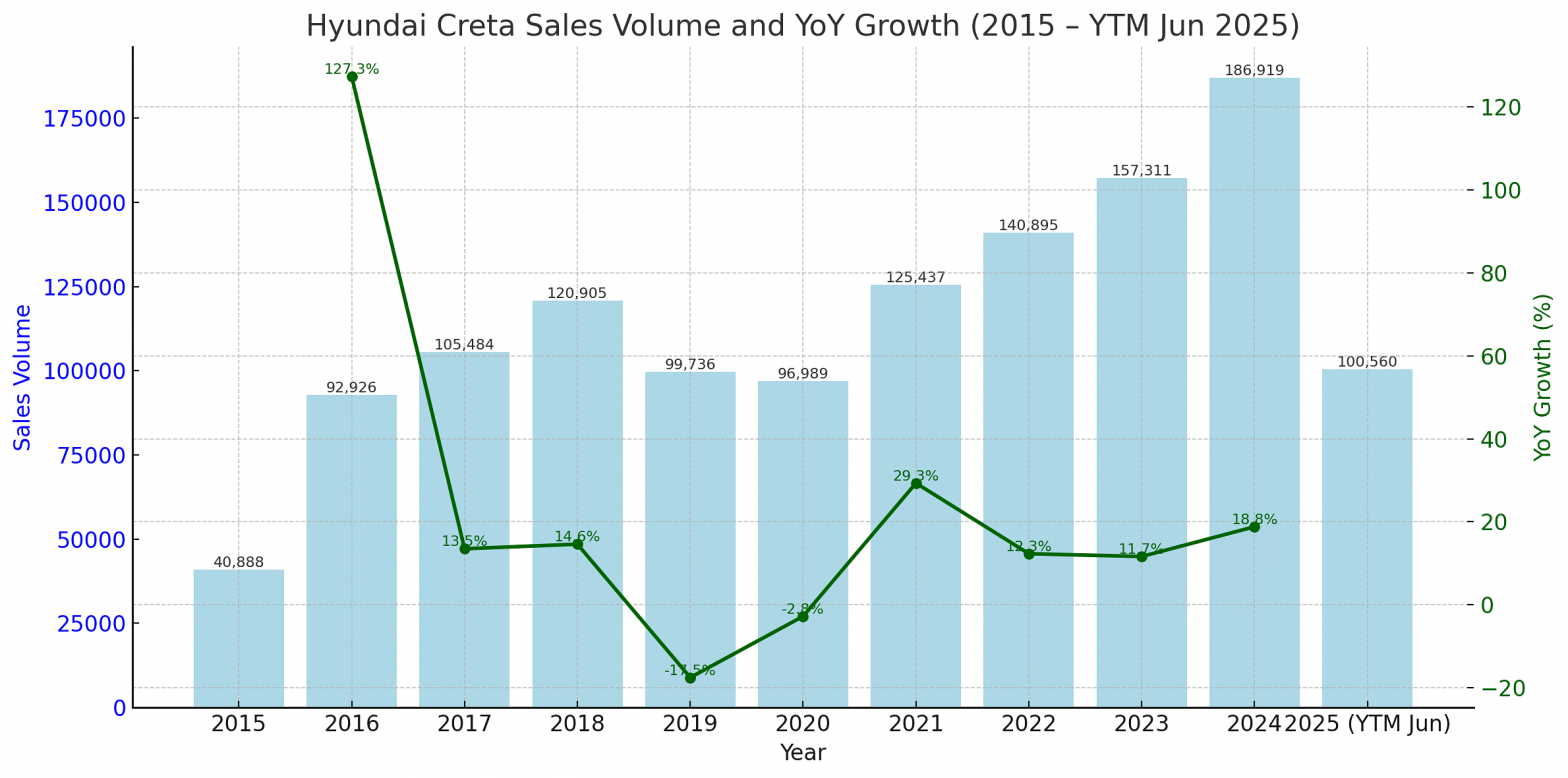When Hyundai launched the Creta in 2015, it began as a stylish, slightly premium mid-size SUV but quickly became the gold standard in its category. Now, a decade later, with over 1.2 million units sold in India, the Creta continues to be the default upgrade for a generation of car buyers seeking aspiration, reliability, and value in one package.
“The journey of Hyundai CRETA is deeply emotional, not just for us, but for every customer who made it a part of their lives,” says Unsoo Kim, Managing Director of Hyundai Motor India. “It stood for dreams, freedom and progress. Over the past 10 years, it has become the gold standard for the Indian SUV buyer.”
From 2016 onward, the Creta has led the mid-size SUV segment. It’s a feat made more impressive considering the segment’s exponential growth and increasingly tough competition. Kia Seltos, Maruti Suzuki Grand Vitara, Toyota Urban Cruiser Hyryder, VW Taigun, Honda Elevate, and Skoda Kushaq have all entered the ring, but couldn’t unseat it from the top.
In the April–June 2025 quarter, the Creta posted wholesales of 47,662 units, ahead of the Hyryder’s 25,471 and holding its own even against the combined strength of Maruti’s Ertiga and Grand Vitara at 65,250 units.
“The Hyundai CRETA is more than a model, it is a living legacy, crafted with care, evolved with technology, and backed by millions of customers who made it their own,” says Tarun Garg, Whole-Time Director and COO, Hyundai Motor India. “As India’s SUV ambitions grew, CRETA too grew with them and if I may dare say, often grew ahead of these ambitions.”
Numbers Tell the Story
 From just 40,888 units in 2015, Creta sales doubled the very next year, crossing 92,000. Despite some softness during the pandemic, the SUV bounced back stronger, hitting a new high of 186,919 units in 2024. As of June 2025, year-to-date sales have already crossed 100,000 units, putting it on track for yet another record year.
From just 40,888 units in 2015, Creta sales doubled the very next year, crossing 92,000. Despite some softness during the pandemic, the SUV bounced back stronger, hitting a new high of 186,919 units in 2024. As of June 2025, year-to-date sales have already crossed 100,000 units, putting it on track for yet another record year.
Hyundai has managed to keep the Creta fresh with clockwork precision: three generations launched across ten years: 2015, 2020, and the most recent in 2024. Unlike many rivals that rely heavily on cosmetic facelifts, Hyundai has consistently reworked both design and tech features to match evolving consumer expectations.
Feature-rich trims, a wide variant mix, and customer-first design touches have played a key role. Sunroof-equipped variants alone now contribute nearly 70% of domestic sales (Jan–June 2025), underscoring how Hyundai has anticipated the growing demand for aspirational features even in non-luxury segments.
Its global appeal also adds weight to the brand: over 2.87 lakh units have been exported from India to more than 13 countries, strengthening the Creta’s position not just as a domestic leader but also as a key contributor to Hyundai’s international playbook.
More Than a Product
According to Raj Shah, Principal Consultant at Coherent Market Insight, Creta’s decade-long dominance isn’t accidental. “Creta’s success reflects Hyundai’s strategic foresight in anticipating market shifts and consumer aspirations. With rising SUV demand, strong rural penetration, and potential hybrid or EV variants, Creta is well-positioned to unlock its next growth phase cementing its role as the cornerstone of Hyundai’s premium and future-ready portfolio in India’s dynamic automotive landscape.”
Shah credits Hyundai for getting the basics right while continuously evolving. “Hyundai has been proactive, not reactive, offering timely upgrades like connected tech, turbo engines, ADAS, and even ventilated seats when few competitors were thinking along those lines,” he says. “What gives it cult status is its ability to resonate with multiple generations; it’s aspirational but attainable.”
That resonance has also helped reposition Hyundai’s brand identity. “Creta redefined how people viewed Hyundai: from just a ‘value for money’ brand to a premium, tech-forward automaker,” Shah adds. “In fact, when you think of Hyundai today, Creta is often the first image that comes to mind.”
Can It Stay on Top?
While the Creta still rules the roost, the road ahead isn’t without challenges. The segment is evolving rapidly, and so are consumer expectations. According to Gaurav Vangaal, Associate Director, Light Vehicle Production Forecast, Indian Subcontinent, S&P Global Mobility, “It was able to retain sales because there were no B-segment good SUVs available in the market earlier. Now things will get more difficult going forward because Maruti has already launched a hybrid, and Mahindra and Tata are also targeting the segment.”
He adds that while Creta gives the customers a peace of mind and ticks all the boxes, whether it’ll be able to maintain this legacy is the question because of the dynamic nature of the competition.
He says that the aspirational curve shifting will play a role in defining its future years in the market: “When the vehicle was launched, the aspiration was to buy a B-segment SUV. Now there’s an aspiration to buy a C or D-segment SUV.”
With Mahindra’s upcoming models and Tata’s Sierra EV expected to disrupt the status quo, Hyundai may also need to rethink its diesel-heavy lineup as stricter emissions norms and rising diesel costs begin to weigh on buyer decisions.
“There’s still headroom to grow. But for the Creta to peak again in its next lifecycle, Hyundai will have to respond fast to market shifts. For now, Hyundai has to rethink its overdependence on one product,” Vangaal says.
What Next for Creta?
For Hyundai, the challenge isn’t just to maintain Creta’s success but to evolve it into a new phase of leadership. This could mean expanding the lineup with hybrid or electric variants or positioning it more aggressively in semi-urban markets, where growth is still robust.
“Rather than a plateau, I’d call this a transition point. Creta’s next wave of growth is just beginning,” says Shah. “There’s untapped potential in rural and semi-urban India, and if Hyundai introduces hybrid or electric variants down the line, that could unlock an entirely new growth cycle.”
As Tarun Garg puts it: “From just 2 models in 2015 to 12 models today, the mid-SUV segment has become fiercely competitive, yet Hyundai CRETA continues to lead, grow and define the category it helped create.”
Experts say that from here on, whether the brand can continue to dominate will depend on how Hyundai adapts to a new era of electrification, premiumisation, and rising expectations.
CRETA Key Facts
- Launched in 2015
- More than 1.2 million units of CRETA sold to date
- Since 2016, CRETA has been the highest selling vehicle in its segment every year
- 3 generations of CRETA launched in 10 years – First launched in 2015 | 2020 – Launch of 2nd generation CRETA | 2024 – Launch of 3rd Generation CRETA
- 2 special editions launched – CRETA Knight Edition (2022); CRETA Adventure Edition (2023)
- 2.87 lakh CRETA exported from India to over 13 countries
- Sunroof-equipped variant contributes about 70% to CRETA sales (Jan – June 2025)
- The Brand generates over $3 billion in revenues for the company annually, accounting for more than a third of Hyundai’s revenues.
